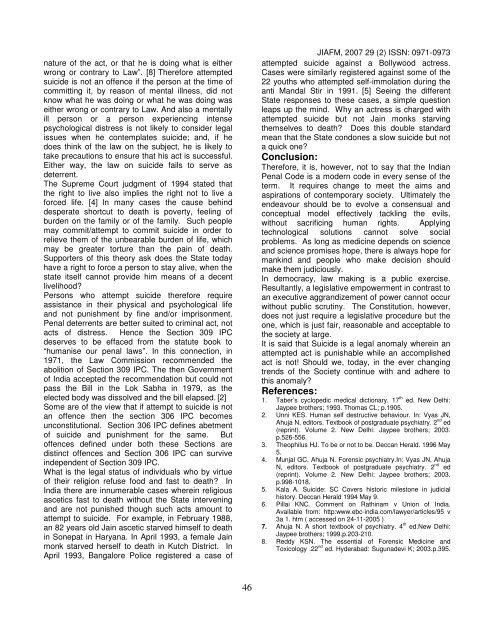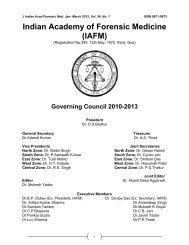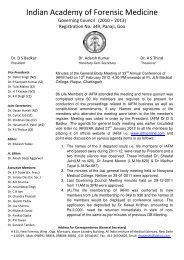Journal of Indian Academy of Forensic Medicine (JIAFM)
Journal of Indian Academy of Forensic Medicine (JIAFM)
Journal of Indian Academy of Forensic Medicine (JIAFM)
You also want an ePaper? Increase the reach of your titles
YUMPU automatically turns print PDFs into web optimized ePapers that Google loves.
nature <strong>of</strong> the act, or that he is doing what is either<br />
wrong or contrary to Law”. [8] Therefore attempted<br />
suicide is not an <strong>of</strong>fence if the person at the time <strong>of</strong><br />
committing it, by reason <strong>of</strong> mental illness, did not<br />
know what he was doing or what he was doing was<br />
either wrong or contrary to Law. And also a mentally<br />
ill person or a person experiencing intense<br />
psychological distress is not likely to consider legal<br />
issues when he contemplates suicide; and, if he<br />
does think <strong>of</strong> the law on the subject, he is likely to<br />
take precautions to ensure that his act is successful.<br />
Either way, the law on suicide fails to serve as<br />
deterrent.<br />
The Supreme Court judgment <strong>of</strong> 1994 stated that<br />
the right to live also implies the right not to live a<br />
forced life. [4] In many cases the cause behind<br />
desperate shortcut to death is poverty, feeling <strong>of</strong><br />
burden on the family or <strong>of</strong> the family. Such people<br />
may commit/attempt to commit suicide in order to<br />
relieve them <strong>of</strong> the unbearable burden <strong>of</strong> life, which<br />
may be greater torture than the pain <strong>of</strong> death.<br />
Supporters <strong>of</strong> this theory ask does the State today<br />
have a right to force a person to stay alive, when the<br />
state itself cannot provide him means <strong>of</strong> a decent<br />
livelihood?<br />
Persons who attempt suicide therefore require<br />
assistance in their physical and psychological life<br />
and not punishment by fine and/or imprisonment.<br />
Penal deterrents are better suited to criminal act, not<br />
acts <strong>of</strong> distress. Hence the Section 309 IPC<br />
deserves to be effaced from the statute book to<br />
“humanise our penal laws”. In this connection, in<br />
1971, the Law Commission recommended the<br />
abolition <strong>of</strong> Section 309 IPC. The then Government<br />
<strong>of</strong> India accepted the recommendation but could not<br />
pass the Bill in the Lok Sabha in 1979, as the<br />
elected body was dissolved and the bill elapsed. [2]<br />
Some are <strong>of</strong> the view that if attempt to suicide is not<br />
an <strong>of</strong>fence then the section 306 IPC becomes<br />
unconstitutional. Section 306 IPC defines abetment<br />
<strong>of</strong> suicide and punishment for the same. But<br />
<strong>of</strong>fences defined under both these Sections are<br />
distinct <strong>of</strong>fences and Section 306 IPC can survive<br />
independent <strong>of</strong> Section 309 IPC.<br />
What is the legal status <strong>of</strong> individuals who by virtue<br />
<strong>of</strong> their religion refuse food and fast to death? In<br />
India there are innumerable cases wherein religious<br />
ascetics fast to death without the State intervening<br />
and are not punished though such acts amount to<br />
attempt to suicide. For example, in February 1988,<br />
an 82 years old Jain ascetic starved himself to death<br />
in Sonepat in Haryana. In April 1993, a female Jain<br />
monk starved herself to death in Kutch District. In<br />
April 1993, Bangalore Police registered a case <strong>of</strong><br />
46<br />
<strong>JIAFM</strong>, 2007 29 (2) ISSN: 0971-0973<br />
attempted suicide against a Bollywood actress.<br />
Cases were similarly registered against some <strong>of</strong> the<br />
22 youths who attempted self-immolation during the<br />
anti Mandal Stir in 1991. [5] Seeing the different<br />
State responses to these cases, a simple question<br />
leaps up the mind. Why an actress is charged with<br />
attempted suicide but not Jain monks starving<br />
themselves to death? Does this double standard<br />
mean that the State condones a slow suicide but not<br />
a quick one?<br />
Conclusion:<br />
Therefore, it is, however, not to say that the <strong>Indian</strong><br />
Penal Code is a modern code in every sense <strong>of</strong> the<br />
term. It requires change to meet the aims and<br />
aspirations <strong>of</strong> contemporary society. Ultimately the<br />
endeavour should be to evolve a consensual and<br />
conceptual model effectively tackling the evils,<br />
without sacrificing human rights. Applying<br />
technological solutions cannot solve social<br />
problems. As long as medicine depends on science<br />
and science promises hope, there is always hope for<br />
mankind and people who make decision should<br />
make them judiciously.<br />
In democracy, law making is a public exercise.<br />
Resultantly, a legislative empowerment in contrast to<br />
an executive aggrandizement <strong>of</strong> power cannot occur<br />
without public scrutiny. The Constitution, however,<br />
does not just require a legislative procedure but the<br />
one, which is just fair, reasonable and acceptable to<br />
the society at large.<br />
It is said that Suicide is a legal anomaly wherein an<br />
attempted act is punishable while an accomplished<br />
act is not! Should we, today, in the ever changing<br />
trends <strong>of</strong> the Society continue with and adhere to<br />
this anomaly?<br />
References:<br />
1. Taber’s cyclopedic medical dictionary. 17 th ed. New Delhi:<br />
Jaypee brothers; 1993. Thomas CL; p.1905.<br />
2. Unni KES. Human self destructive behaviour. In: Vyas JN,<br />
Ahuja N, editors. Textbook <strong>of</strong> postgraduate psychiatry. 2 nd ed<br />
(reprint). Volume 2. New Delhi: Jaypee brothers; 2003.<br />
p.526-556.<br />
3. Theophilus HJ. To be or not to be. Deccan Herald. 1996 May<br />
5.<br />
4. Munjal GC, Ahuja N. <strong>Forensic</strong> psychiatry.In: Vyas JN, Ahuja<br />
N, editors. Textbook <strong>of</strong> postgraduate psychiatry. 2 nd ed<br />
(reprint). Volume 2. New Delhi: Jaypee brothers; 2003.<br />
p.998-1018.<br />
5. Kala A. Suicide: SC Covers historic milestone in judicial<br />
history. Deccan Herald 1994 May 9.<br />
6. Pillai KNC. Comment on Rathinam v Union <strong>of</strong> India.<br />
Available from: http:www.ebc-india.com/lawyer/articles/95 v<br />
3a 1. htm ( accessed on 24-11-2005 )<br />
7. Ahuja N. A short textbook <strong>of</strong> psychiatry. 4 th ed.New Delhi:<br />
Jaypee brothers; 1999.p.203-210.<br />
8. Reddy KSN. The essential <strong>of</strong> <strong>Forensic</strong> <strong>Medicine</strong> and<br />
Toxicology .22 nd ed. Hyderabad: Sugunadevi K; 2003.p.395.









